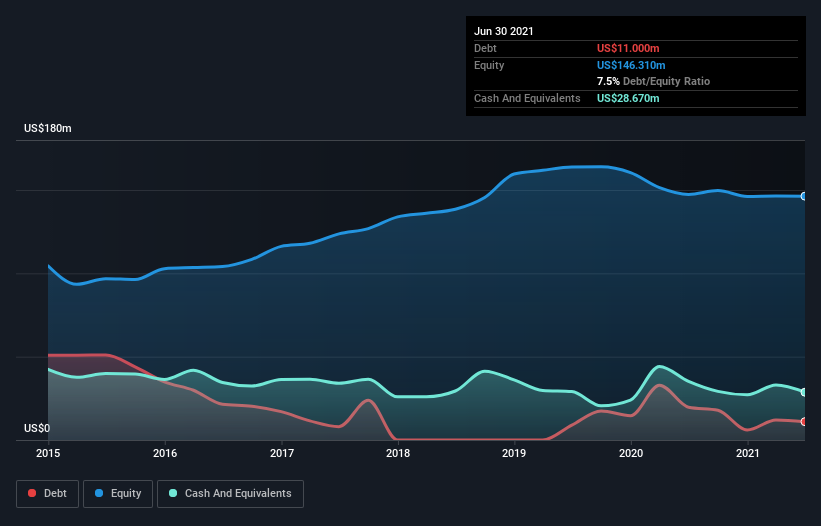Here's Why Ceragon Networks (NASDAQ:CRNT) Can Manage Its Debt Responsibly
Warren Buffett famously said, 'Volatility is far from synonymous with risk.' So it might be obvious that you need to consider debt, when you think about how risky any given stock is, because too much debt can sink a company. Importantly, Ceragon Networks Ltd. (NASDAQ:CRNT) does carry debt. But the real question is whether this debt is making the company risky.
What Risk Does Debt Bring?
Generally speaking, debt only becomes a real problem when a company can't easily pay it off, either by raising capital or with its own cash flow. Part and parcel of capitalism is the process of 'creative destruction' where failed businesses are mercilessly liquidated by their bankers. However, a more frequent (but still costly) occurrence is where a company must issue shares at bargain-basement prices, permanently diluting shareholders, just to shore up its balance sheet. Having said that, the most common situation is where a company manages its debt reasonably well - and to its own advantage. When we think about a company's use of debt, we first look at cash and debt together.
See our latest analysis for Ceragon Networks
What Is Ceragon Networks's Debt?
You can click the graphic below for the historical numbers, but it shows that Ceragon Networks had US$11.0m of debt in June 2021, down from US$19.7m, one year before. But on the other hand it also has US$28.7m in cash, leading to a US$17.7m net cash position.
A Look At Ceragon Networks' Liabilities
Zooming in on the latest balance sheet data, we can see that Ceragon Networks had liabilities of US$106.7m due within 12 months and liabilities of US$41.5m due beyond that. Offsetting these obligations, it had cash of US$28.7m as well as receivables valued at US$124.8m due within 12 months. So it actually has US$5.32m more liquid assets than total liabilities.
This state of affairs indicates that Ceragon Networks' balance sheet looks quite solid, as its total liabilities are just about equal to its liquid assets. So while it's hard to imagine that the US$282.2m company is struggling for cash, we still think it's worth monitoring its balance sheet. Simply put, the fact that Ceragon Networks has more cash than debt is arguably a good indication that it can manage its debt safely.
It was also good to see that despite losing money on the EBIT line last year, Ceragon Networks turned things around in the last 12 months, delivering and EBIT of US$12m. When analysing debt levels, the balance sheet is the obvious place to start. But it is future earnings, more than anything, that will determine Ceragon Networks's ability to maintain a healthy balance sheet going forward. So if you're focused on the future you can check out this free report showing analyst profit forecasts.
Finally, while the tax-man may adore accounting profits, lenders only accept cold hard cash. While Ceragon Networks has net cash on its balance sheet, it's still worth taking a look at its ability to convert earnings before interest and tax (EBIT) to free cash flow, to help us understand how quickly it is building (or eroding) that cash balance. Over the last year, Ceragon Networks saw substantial negative free cash flow, in total. While that may be a result of expenditure for growth, it does make the debt far more risky.
Summing up
While we empathize with investors who find debt concerning, you should keep in mind that Ceragon Networks has net cash of US$17.7m, as well as more liquid assets than liabilities. So we are not troubled with Ceragon Networks's debt use. There's no doubt that we learn most about debt from the balance sheet. However, not all investment risk resides within the balance sheet - far from it. Be aware that Ceragon Networks is showing 1 warning sign in our investment analysis , you should know about...
If, after all that, you're more interested in a fast growing company with a rock-solid balance sheet, then check out our list of net cash growth stocks without delay.
This article by Simply Wall St is general in nature. We provide commentary based on historical data and analyst forecasts only using an unbiased methodology and our articles are not intended to be financial advice. It does not constitute a recommendation to buy or sell any stock, and does not take account of your objectives, or your financial situation. We aim to bring you long-term focused analysis driven by fundamental data. Note that our analysis may not factor in the latest price-sensitive company announcements or qualitative material. Simply Wall St has no position in any stocks mentioned.
Have feedback on this article? Concerned about the content? Get in touch with us directly. Alternatively, email editorial-team (at) simplywallst.com.

